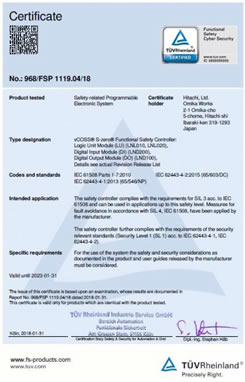Information contained in this news release is current as of the date of the press announcement, but may be subject to change without prior notice.
February 5, 2018
The design and development processes comply with the highest-level SIL 4*1
requirements of IEC 61508 series functional safety standard
![[image]Functional safety controller “νCOSS S-zero”](180205-1.jpg)
Functional safety controller "νCOSS S-zero"
Tokyo, 05th February 2018 - Hitachi, Ltd. (TSE: 6501, "Hitachi") and Hitachi-GE Nuclear Energy, Ltd. ("Hitachi-GE") today announced that the jointly developed functional safety controller "νCOSS S-zero" for the UK Advanced Boiling Water Reactor ("UK ABWR") has been certified for Safety Integrity Levels ("SIL") 3*1 according to IEC 61508 series functional safety standard, by German-based international third-party certifier TÜV Rheinland Industrie Service GmbH ("TÜV Rheinland").
The certificate confirms the measures for fault avoidance ("design and development processes") comply with the highest-level SIL 4*1 requirements of IEC 61508 series functional safety standard. This enables the product to be used in systems that require compliance with SIL 4*1 , which was difficult to realize with conventional programmable functional safety controllers, if additional system level measures to meet SIL 4*1 requirements are applied. The "νCOSS S-zero" has also been certified for Security Level ("SL") 1*2 according to IEC 62443-4 series cyber security standard through a combined assessment by TÜV Rheinland.
Furthermore, the "νCOSS S-zero" was assessed as a part of the UK Regulators' Generic Design Assessment for UK ABWR, which was completed in December 2017. Its general approach for hardware design and development is recognized as meeting regulatory expectations.
IEC 61508 series is a set of international functional safety standard defined by the International Electrotechnical Commission*3 to realize protection through computer technologies. The standard defines requirements for electric, electronic or programmable electronic safety protection systems to detect an abnormal state in machines and facilities used in factories and plants and maintain safety, based on the concept of reducing risks to an allowable target level.
The "νCOSS S-zero" is a controller that activates safety protection functions to put a plant into a safe state in the event of an abnormal situation, independent of the control systems for the operation and monitoring of the plant.
It does not use firmware, OS or middleware, which are generally required for controllers, but implements system specific controls by combining hardware calculation elements. This achieves a high level of safety, reliability and security against cyber-attacks. The control logic is able to use floating point arithmetic calculations*4 .The calculation elements were developed in-house to enable safety evaluations meeting the SIL 4*1 requirements.
Hitachi-GE intends to incorporate the "νCOSS S-zero" as the functional safety controller for the nuclear facilities it provides to Horizon Nuclear Power, for their projects in the UK. In addition, because there are few programmable functional safety controllers available in the world whose design and development processes are recognized to comply with SIL 4*1 requirements, Hitachi seeks to expand the application to areas such as chemical plants and turbines for thermal power generation where a high level of safety and reliability is required.
"νCOSS S-zero" is a trademark or registered trademark of Hitachi, Ltd.
Hitachi, Ltd. (TSE: 6501), headquartered in Tokyo, Japan, delivers innovations that answer society's challenges. The company's consolidated revenues for fiscal 2016 (ended March 31, 2017) totaled 9,162.2 billion yen ($81.8 billion). The Hitachi Group is a global leader in the Social Innovation Business, and it has approximately 304,000 employees worldwide. Through collaborative creation, Hitachi is providing solutions to customers in a broad range of sectors, including Power / Energy, Industry / Distribution / Water, Urban Development, and Finance / Government & Public / Healthcare. For more information on Hitachi, please visit the company's website at http://www.hitachi.com.
Hitachi-GE, a joint venture established by Hitachi, Ltd. (TSE:6501) and GE in July 2007, as one of the world's leading comprehensive plant manufacturers, engages in the development, planning, design, manufacture, inspection, installation, pre-operation, and maintenance of nuclear reactor-related equipment and is able to execute integrated project management. Hitachi-GE has been involved with 23 reactors in Japan to date, including those currently under construction. For more information about Hitachi-GE, please visit http://www.hitachi-hgne.co.jp/en/index.html.

Certificate
Enlarge image (open in new window)